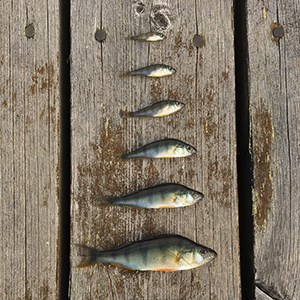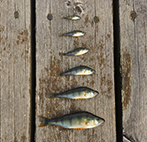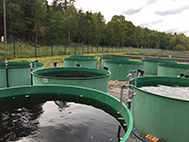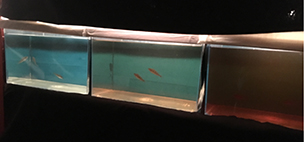Less fish when waters become warmer and browner

Many aquatic ecosystems in Northern Europe are getting both warmer and browner due to climate change, which affects the organisms living in lakes and coastal areas. A new doctoral dissertation from SLU shows that future warming and browning will likely lead to lakes with fewer, smaller, younger and slower growing fish, which likely will lead to less fish biomass production.
Recent and future warming and browning of aquatic systems may affect body growth of fish because of direct temperature effects on many biological rates, such as metabolism and feeding rates, and light limitation due to browning can affect visual feeding of fish as well as the production, abundance and composition of their prey.
In a new doctoral thesis from SLU, Renee van Dorst has investigated the effects of warmer and browner waters on fish individuals and populations. To do this, she used a range of methods, including observational fish data, a whole-ecosystem warming experiment, aquaria experiments, and mesocosm experiments. She studied the responses of two common European freshwater fish species: European perch (Perca fluviatilis) and common roach (Rutilus rutilus).
“My research shows that both warming and browning of lakes will likely lead to a decrease in fish biomass production. Warming will likely do this by causing a shift towards smaller and younger individuals and also a lower fish population biomass. Browning on the other hand will likely have negative effects on fish biomass production because it leads to lower fish body growth.” says Renee van Dorst.
In her work Renee also studied if the effects of warming and browning differed with body size, sex, and between species. She found that responses to warming indeed depended on fish body size, as body growth of small, but not large, individuals was positively affected by warm temperatures. She also found sex-specific responses to warming, as body growth of males was more negatively affected by warming than female body growth.
Responses to browning varied with both body size and species identity. She found that perch body growth was always negatively affected by browning, but that effects were stronger for larger fish, while roach only seem to be negatively affected by browning when they were very small.
In her thesis, Renee concludes that climate change, and the warming and browning of aquatic ecosystems that follows, will negatively affect fish individuals and populations, but that responses will vary with size, sex, and species. As fish play important roles in aquatic ecosystems, these impacts of warming and browning will likely cascade through entire lake ecosystems.
“I hope that my thesis contributes to a broader understanding of how aquatic systems will respond to future climate change”, concludes Renee van Dorst.
---------------------------------------
Renee van Dorst defended her PhD thesis Warmer and browner waters: fish responses vary with size, sex, and species on september 4, 2020, at SLU i Uppsala.
More information
Renee van Dorst
Department of Aquatic Resources; Institute of Coastal Research
Swedish University of Agricultural Sciences, Öregrund
renee.van.dorst@slu.se
Link till the thesis (pdf)
https://pub.epsilon.slu.se/17355/
Press images
(May be published without charge in articles about this press release, please acknowledge the photographer)
The size of even-aged perch can vary considerably. These perches are however from another study. Photo: Renee van Dorst
Large tanks (7000 liters) were used to study the effects of browner water on body growth in fish. Photo: Renee van Dorst
Aquaria were used to study how browner water affects feeding behaviour in fish. Photo: Renee van Dorst


